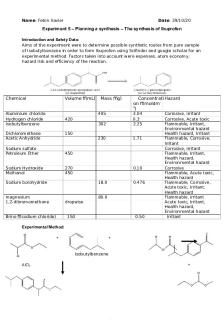[QO3] Synthesis of Para Red (Mechanism) PDF
![[QO3] Synthesis of Para Red (Mechanism)](https://pdfedu.com/img/crop/300x450/m52yx4dzw3eq.jpg)
| Title | [QO3] Synthesis of Para Red (Mechanism) |
|---|---|
| Author | Steeven Alquinga |
| Course | Termodinamica |
| Institution | Universidad Central del Ecuador |
| Pages | 2 |
| File Size | 255.1 KB |
| File Type | |
| Total Downloads | 70 |
| Total Views | 123 |
Summary
Sintesis de Para Red colorsnte azoico...
Description
CENTRAL UNIVERSITY OF ECUADOR FACULTY OF CHEMICAL ENGINEERING ORGANIC CHEMISTRY III
Reaction mechanism for the synthesis of Para Red Richard Elvis Núñez Ochoa
25-05-2019
Synthesis of the azo dye known as Para Red from p-nitroaniline, β-naphthol (2-naphthol), sodium nitrite and muriatic acid. Procedure retrieved from "Introduction to Organic Laboratory Techniques", 3rd Edition - Pavia, Lampman & Kriz. Developed in Chem Draw Professional (ChemOffice Pro 16.0 Suite). Guiding teacher: Dr. Ullrich Stahl, Ph.D. 1. Electrophilic Generation Formation of nitrosonium ion [NO+] from a more stable compound such as sodium nitrite. The nitrite reacts with hydrochloric acid to form the nitrous acid that makes it possible to obtain the ion that will be used for diazotation.
2. Diazotation / Diazotization Para-nitroaniline reacts with the nitrosonium ion in such a way that the union between both nitrogens is formed, being a precursor for the appearance of the functional group (azo), inside the final molecule of the dye. In the process, a water molecule is eliminated and experimentally this reaction must be given at low temperature, since it is an exothermic reaction that if it is not controlled can decompose the dye. P-nitroaniline is a compound with which diazotization can occur due to the nitro group it possesses. This functional group pulls electrons and allows the amine to react with the nitrosonium ion. If it did not have the nitro group (-NO2), it simply could not have this reaction. The molecule must have a functional group that pulls electrons and helps the amine.
3. Copulation (Azo coupling) Due to the hydroxyl group present in naphthol, it is a strong activator that will orient in ortho and para position for its coupling with the diazo compound. Due to the disposition of the molecule, copulation will occur in the ortho position. In this step the resonance of the molecule must be performed to observe the positions where the diazo compound will attack. By movement of the oxygen free electrons in the hydroxyl group, a double bond is formed leaving the oxygen with a formal charge of 1+ and the adjacent carbon in the ortho position will be available to react. Teaching assistant: Richard E. Núñez O.
1
CENTRAL UNIVERSITY OF ECUADOR FACULTY OF CHEMICAL ENGINEERING ORGANIC CHEMISTRY III
Even if α-naphthol (1-naphthol) was used for the coupling, it would occur in the ortho position because it has more space than the para position. It is enough to analyze this reasoning when observing Eriochrome Black T, which is an azo dye used as a complexometric indicator to analyze water hardness. Figure 1. Structure of Eriochrome Black T
Source: Sigma-Aldrich (2019) Eriochrome® Black T
References: • Pavia, Lampman & Kriz (2004) "Introduction to Organic Laboratory Techniques", Third edition. United States of America: Cengage Learning. • New Mexico Tech (undated) “Diazo Coupling: A Synthesis of Methyl Orange”. CHEM 334L. Organic Chemistry Laboratory. Revision 2.0. Retrieved April 29, 2018. Available at: https://infohost.nmt.edu/~jaltig/Diazo.pdf • Sigma-Aldrich (2019) Eriochrome® Black T. ACS reagent (indicator grade). Merck KGaA, Darmstadt, Germany and/or its affiliates. Retrieved May 25, 2019. Available at: https://www.sigmaaldrich.com/catalog/product/sial/858390?lang=en®ion=EC
Teaching assistant: Richard E. Núñez O.
2...
Similar Free PDFs

The mechanism of labour
- 2 Pages

Mechanism of softening effect
- 7 Pages

SYNTHESIS OF DIMETHYL ETHER
- 54 Pages

Synthesis of Isopentyl Acetate
- 4 Pages

Synthesis of Sudan-1
- 4 Pages

The synthesis of Ibuprofen
- 4 Pages

Synthesis of methyl orange
- 9 Pages

Synthesis of Aspirin
- 10 Pages

Synthesis of Acetanilide
- 5 Pages

insurance mechanism
- 49 Pages

Dehydration - mechanism
- 2 Pages

Synthesis of p-nitroacetanilide
- 6 Pages

Synthesis of Flavonol 2
- 13 Pages

Synthesis of Cyclohexene
- 8 Pages

Defense Mechanism
- 2 Pages
Popular Institutions
- Tinajero National High School - Annex
- Politeknik Caltex Riau
- Yokohama City University
- SGT University
- University of Al-Qadisiyah
- Divine Word College of Vigan
- Techniek College Rotterdam
- Universidade de Santiago
- Universiti Teknologi MARA Cawangan Johor Kampus Pasir Gudang
- Poltekkes Kemenkes Yogyakarta
- Baguio City National High School
- Colegio san marcos
- preparatoria uno
- Centro de Bachillerato Tecnológico Industrial y de Servicios No. 107
- Dalian Maritime University
- Quang Trung Secondary School
- Colegio Tecnológico en Informática
- Corporación Regional de Educación Superior
- Grupo CEDVA
- Dar Al Uloom University
- Centro de Estudios Preuniversitarios de la Universidad Nacional de Ingeniería
- 上智大学
- Aakash International School, Nuna Majara
- San Felipe Neri Catholic School
- Kang Chiao International School - New Taipei City
- Misamis Occidental National High School
- Institución Educativa Escuela Normal Juan Ladrilleros
- Kolehiyo ng Pantukan
- Batanes State College
- Instituto Continental
- Sekolah Menengah Kejuruan Kesehatan Kaltara (Tarakan)
- Colegio de La Inmaculada Concepcion - Cebu
![[QO3] Synthesis of Para Red (Mechanism)](https://pdfedu.com/img/crop/172x258/m52yx4dzw3eq.jpg)